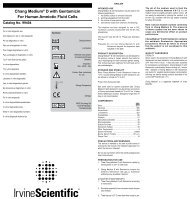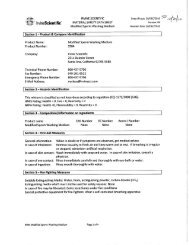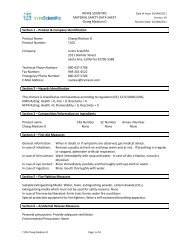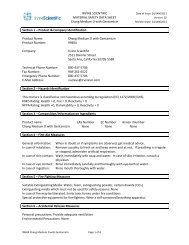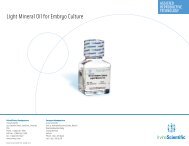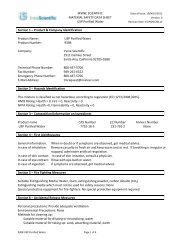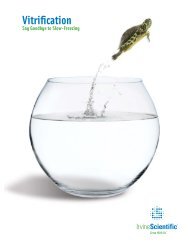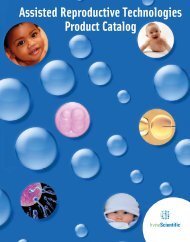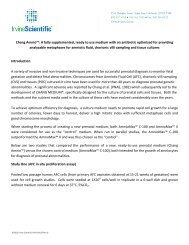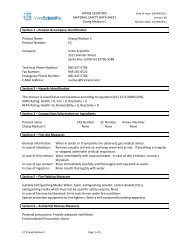Article Comparison of open and closed methods for ... - Irvine Scientific
Article Comparison of open and closed methods for ... - Irvine Scientific
Article Comparison of open and closed methods for ... - Irvine Scientific
Create successful ePaper yourself
Turn your PDF publications into a flip-book with our unique Google optimized e-Paper software.
<strong>Article</strong> - Vitrification <strong>of</strong> human embryos - M Kuwayama et al.<br />
<strong>and</strong> slow cooling to –30°C prior to plunging into liquid nitrogen,<br />
resulted in the introduction <strong>of</strong> cryopreservation as a st<strong>and</strong>ard<br />
method <strong>of</strong>fered by virtually every full-service IVF programme<br />
world-wide (Anderson et al., 2003).<br />
The primary disadvantages to slow cooling <strong>for</strong> human embryo<br />
cryopreservation are the requirement <strong>for</strong> an expensive<br />
programmable freezing machine <strong>and</strong> the time-consuming<br />
procedure. The introduction <strong>of</strong> a technique that could be per<strong>for</strong>med<br />
without the use <strong>of</strong> costly equipment <strong>and</strong> could be completed by<br />
one cryopreservation specialist within minutes would provide<br />
significant benefits <strong>for</strong> any busy IVF programme.<br />
Vitrification <strong>of</strong> embryos <strong>and</strong> oocytes may <strong>of</strong>fer a solution <strong>for</strong> this<br />
problem. Vitrification can be defined as an extreme elevation<br />
in viscosity, i.e. solidification <strong>of</strong> solutions without ice crystal<br />
<strong>for</strong>mation at low temperature (Liebermann et al., 2002a; Fuller<br />
<strong>and</strong> Paynter, 2004; Kasai, 2004; Liebermann <strong>and</strong> Tucker, 2004).<br />
This phenomenon can be induced by either applying an extreme<br />
cooling rate or by using high concentrations <strong>of</strong> cryoprotectant<br />
solutions. Methods developed <strong>for</strong> vitrification in embryology<br />
use a combination <strong>of</strong> these two possibilities (Liebermann et al.,<br />
2003). The advantages <strong>of</strong> vitrification in embryology may be<br />
considerable. Oocytes <strong>and</strong> embryos are sensitive to ice crystal<br />
<strong>for</strong>mation; consequently, the elimination <strong>of</strong> this type <strong>of</strong> injury<br />
may increase their chances <strong>for</strong> survival. The required high<br />
cooling rate can be achieved by simple <strong>methods</strong> including, <strong>for</strong><br />
example, direct plunging into liquid nitrogen, thus the need<br />
<strong>for</strong> expensive equipment is eliminated. Additionally, the time<br />
required <strong>for</strong> equilibration <strong>and</strong> cooling is considerably reduced. On<br />
the other h<strong>and</strong>, disadvantages <strong>of</strong> vitrification are the required high<br />
cryoprotectant concentration, <strong>and</strong> consequently the increased risk<br />
<strong>of</strong> toxic <strong>and</strong> osmotic damage, <strong>and</strong> the need to use special tools<br />
permitting high cooling rate by reducing radically the volume <strong>of</strong><br />
solutions containing the embryos.<br />
Successful vitrification <strong>of</strong> mammalian embryos was first reported<br />
by Rall <strong>and</strong> Fahy in 1985. Since then, a number <strong>of</strong> cryoprotectant<br />
solutions have been investigated <strong>for</strong> human use including the use<br />
<strong>of</strong> DMSO, glycerol, ethylene glycol, propanediol <strong>and</strong> sugars in<br />
various combinations (Chen et al., 2000; M<strong>and</strong>elbaum, 2000;<br />
Shaw et al., 2000; Wright et al., 2004). In addition, numerous<br />
carrier systems have been tried, including electron microscope<br />
grids, <strong>open</strong> pulled straws, denuding pipettes, <strong>open</strong> hemi-straws,<br />
<strong>and</strong> cryoloops (Martino et al., 1996; Arav <strong>and</strong> Zeron, 1997; Vajta<br />
et al., 1998a,b; Lane et al., 1999; Kuleshova <strong>and</strong> Shaw, 2000; Park<br />
et al., 2000; V<strong>and</strong>erzwalmen et al., 2000; V<strong>and</strong>ervorst et al., 2001;<br />
Yeoman et al., 2001; Liebermann <strong>and</strong> Tucker, 2002; Liebermann<br />
et al., 2002a,b; Mukaida et al., 2002, 2003; Selman <strong>and</strong> El-<br />
Danasouri, 2002; V<strong>and</strong>erzwalment et al., 2002, 2003; Isachenko<br />
et al., 2003; Son et al., 2003, 2005; Cremades et al., 2004; Walker<br />
et al., 2004). While all <strong>of</strong> these systems have their advantages<br />
<strong>and</strong> disadvantages, the primary concern <strong>for</strong> many authorities <strong>and</strong><br />
scientists is the potential risk <strong>of</strong> contamination <strong>for</strong> patients. As<br />
the rapid cooling in all these systems requires direct contact <strong>of</strong><br />
the embryo containing solution <strong>and</strong> liquid nitrogen, there is a<br />
potential risk <strong>of</strong> disease transmission through contaminated liquid<br />
nitrogen during cooling <strong>and</strong> storage (Bielanski et al., 2000).<br />
The purposes <strong>of</strong> this study were: (i) to compare the efficacy <strong>of</strong><br />
vitrification versus traditional slow cooling <strong>for</strong> cryopreservation <strong>of</strong><br />
human embryos, <strong>and</strong> (ii) to investigate the possibility <strong>of</strong> replacing<br />
an earlier <strong>open</strong> system (Cryotop) with a newly introduced<br />
<strong>closed</strong> method (Cryotip TM ) to eliminate the potential danger <strong>of</strong><br />
contamination.<br />
Materials <strong>and</strong> <strong>methods</strong><br />
Patient treatment <strong>and</strong> embryo culture<br />
Experiments were conducted in patients following in<strong>for</strong>med<br />
consent <strong>and</strong> IRB approval. Patients were stimulated during an<br />
IVF cycle by the use <strong>of</strong> clomiphene citrate (Clomid; Shionogi<br />
Co. Ltd, Osaka, Japan). Clomiphene administration (50 mg/<br />
day) was initiated on day 3 <strong>of</strong> the cycle <strong>and</strong> continued until<br />
the rise in LH, caused by the nasal administration <strong>of</strong> 300 μg <strong>of</strong><br />
gonadotrophin-releasing hormone agonist (GnRHa) (Suprecur;<br />
Mochida Pharmaceutical Co. Ltd, Tokyo, Japan). Human<br />
menopausal gonadotrophin (HMG) (Humegon; Organon Co. Ltd,<br />
Netherl<strong>and</strong>s) was initiated on day 8 (150 IU) <strong>and</strong> continued every<br />
other day until the administration <strong>of</strong> GnRHa.<br />
Oocytes were recovered by using a transvaginal ultrasoundguided<br />
device (GM07M05V110; Mochida Pharmaceutical). After<br />
retrieval, oocytes were cultured in TCM199 medium buffered<br />
with 11 mmol/l Hepes, 9 mmol/l Na-Hepes <strong>and</strong> 5 mmol/l NaHCO 3<br />
(referred further as TCM 199) supplemented with 10% Synthetic<br />
Serum Substitute (SSS; <strong>Irvine</strong> <strong>Scientific</strong>, Santa Ana, CA, USA)<br />
in 5% CO 2<br />
in air at 37°C. After 2 h, insemination was per<strong>for</strong>med<br />
by intracytoplasmic sperm injection (ICSI). The following day,<br />
fertilized oocytes with 2 pronuclei <strong>and</strong> two polar bodies were<br />
transferred into 0.5 ml droplets <strong>of</strong> Quinn’s Advantage Cleavage<br />
Medium (Sage BioPharma, USA) supplemented with 10% SSS<br />
<strong>and</strong> cultured further as described above. Embryos that developed<br />
beyond the 4-cell stage on day 5 were transferred into 100 μl<br />
droplets <strong>of</strong> blastocyst medium (<strong>Irvine</strong> <strong>Scientific</strong>) <strong>and</strong> cultured<br />
under identical conditions to day 6 after ICSI.<br />
Vitrification <strong>of</strong> embryos<br />
Equilibration, vitrification, thawing, dilution <strong>and</strong> washing solutions<br />
were equivalents to those in Vit Kit (<strong>Irvine</strong> <strong>Scientific</strong>). At the<br />
time <strong>of</strong> vitrification embryos were transferred into equilibration<br />
solution (ES) consisting <strong>of</strong> 7.5% (v/v) ethylene glycol <strong>and</strong> 7.5%<br />
(v/v) DMSO dissolved in TCM199 supplemented with 20%<br />
SSS at 27°C <strong>for</strong> 5–15 min. After an initial shrinkage, embryos<br />
regained their original volume, <strong>and</strong> were transferred into three 20<br />
µl drops <strong>of</strong> vitrification solution (VS) consisting <strong>of</strong> 15% (v/v) EG<br />
<strong>and</strong> 15%(v/v) DMSO <strong>and</strong> 0.5 mol/l sucrose dissolved in TCM199<br />
supplemented with 20% SSS, After incubation <strong>for</strong> 20 s in each<br />
drop respectively, embryos were loaded into CryoTips (<strong>Irvine</strong><br />
<strong>Scientific</strong>) or on Cryotops <strong>and</strong> plunged into liquid nitrogen.<br />
CryoTip consists <strong>of</strong> a plastic straw with a thin part (250 μm inner<br />
diameter, 20 μm wall thickness <strong>and</strong> 3 cm length) connected to a<br />
thick part (2000 μm inner diameter <strong>and</strong> 150 μm wall thickness,<br />
4.5 cm length) <strong>and</strong> equipped with a movable protective metal<br />
sleeve (Figure 1). Embryos were loaded in approximately 1<br />
μl solution into the narrow part <strong>of</strong> the CryoTips without any<br />
air bubbles by aspiration <strong>of</strong> medium, embryo <strong>and</strong> medium, <strong>and</strong><br />
medium by a connected syringe. Subsequently, the straw was<br />
heat-sealed at both ends, the protective sleeve was pulled over<br />
the narrow part <strong>and</strong> the device was plunged into liquid nitrogen.<br />
The time required <strong>for</strong> loading, sealing, adjustment <strong>of</strong> the sleeve<br />
609



